

You can define finisher settings.
Open the Settings Editor and go to: .
 [Print job defaults] tab
[Print job defaults] tabGo to the [External finisher] section.
 [External finisher] section
[External finisher] sectionUse the [Error recovery method] setting to define how to continue when an error occurs.
[By page without user confirmation]: print the last set again.
[By set with user confirmation]: start at the page after the last known correctly delivered sheet. The printer restarts after user confirmation.
[By set without user confirmation]: print the last set again. The printer restarts automatically after error has been resolved, without user confirmation.
 [Error recovery method] setting
[Error recovery method] settingUse the [Preferred feed edge] setting to indicate the default feed direction of the sheets to the external finisher.
[Long-edge feed (LEF)]: long-edge feed direction.
[Short-edge feed (SEF)]: short-edge feed direction.
 [Preferred feed edge] setting
[Preferred feed edge] settingUse the [Face orientation] setting to define the default face orientation.
[Face up]: the front side of the sheet points up.
[Face down]: the front side of the sheet points down.
 [Face orientation] setting
[Face orientation] settingUse the [Header orientation] setting to define the default orientation of the header.
[Header-up]: the header points toward the back of the printer.
[Header-down]: the header points toward the front of the printer.
 [Header orientation] setting
[Header orientation] settingUse the [Preferred sheet order] setting to define the default order of the printed sheets within a job.
[First sheet first]: deliver the first sheet of each set first.
[Last sheet first]: deliver the last sheet of each set first.
 [Preferred sheet order] setting
[Preferred sheet order] settingUse the [Name] setting to define a meaningful name for the external finisher.
The name of the external finisher is visible in the job properties. Open the job properties and go to: .
 [Name] setting
[Name] settingGo to the [Stacker/stapler] section.
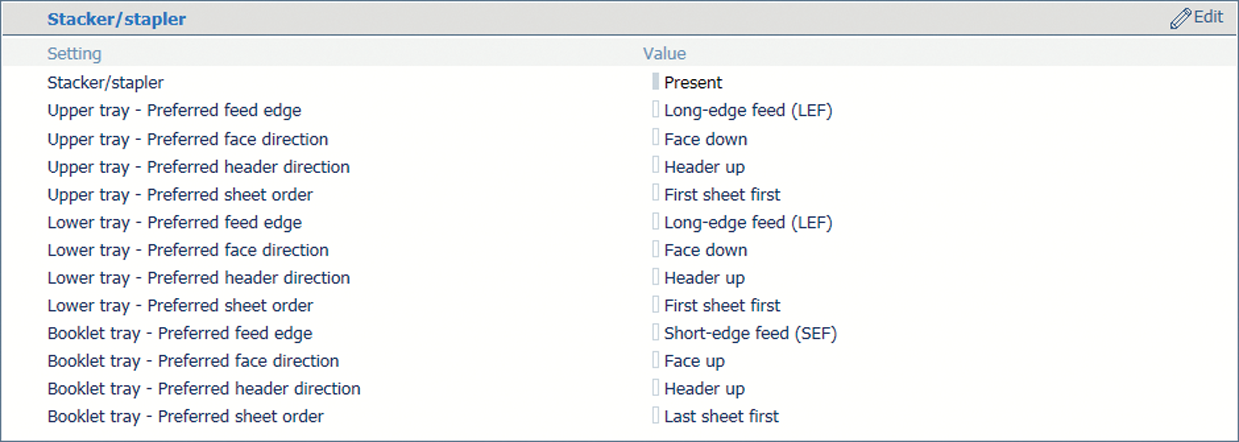 [Stacker/stapler] section
[Stacker/stapler] sectionUse the [Upper tray - Preferred feed edge], [Lower tray - Preferred feed edge] or [Booklet tray - Preferred feed edge] setting to indicate the default feed direction of the sheets on the output tray.
 Preferred feed edge setting
Preferred feed edge settingUse the [Upper tray - Preferred face direction], [Lower tray - Preferred face direction] or [Booklet tray - Preferred face direction] setting to indicate if the front side of the sheets points up or down by default.
 Preferred face direction setting
Preferred face direction settingUse the [Upper tray - Preferred header direction], [Lower tray - Preferred header direction] or [Booklet tray - Preferred header direction] setting to indicate if the header points to the front side of the printer or to the back side of the printer by default.
 Preferred header direction setting
Preferred header direction settingUse the [Upper tray - Preferred sheet order], [Lower tray - Preferred sheet order] or [Booklet tray - Preferred sheet order] setting to indicate the default order of the printed sheets within a job set.
 Preferred sheet order setting
Preferred sheet order settingGo to .
 [System adjustments] tab
[System adjustments] tabGo to the [Finisher adjustments] section.
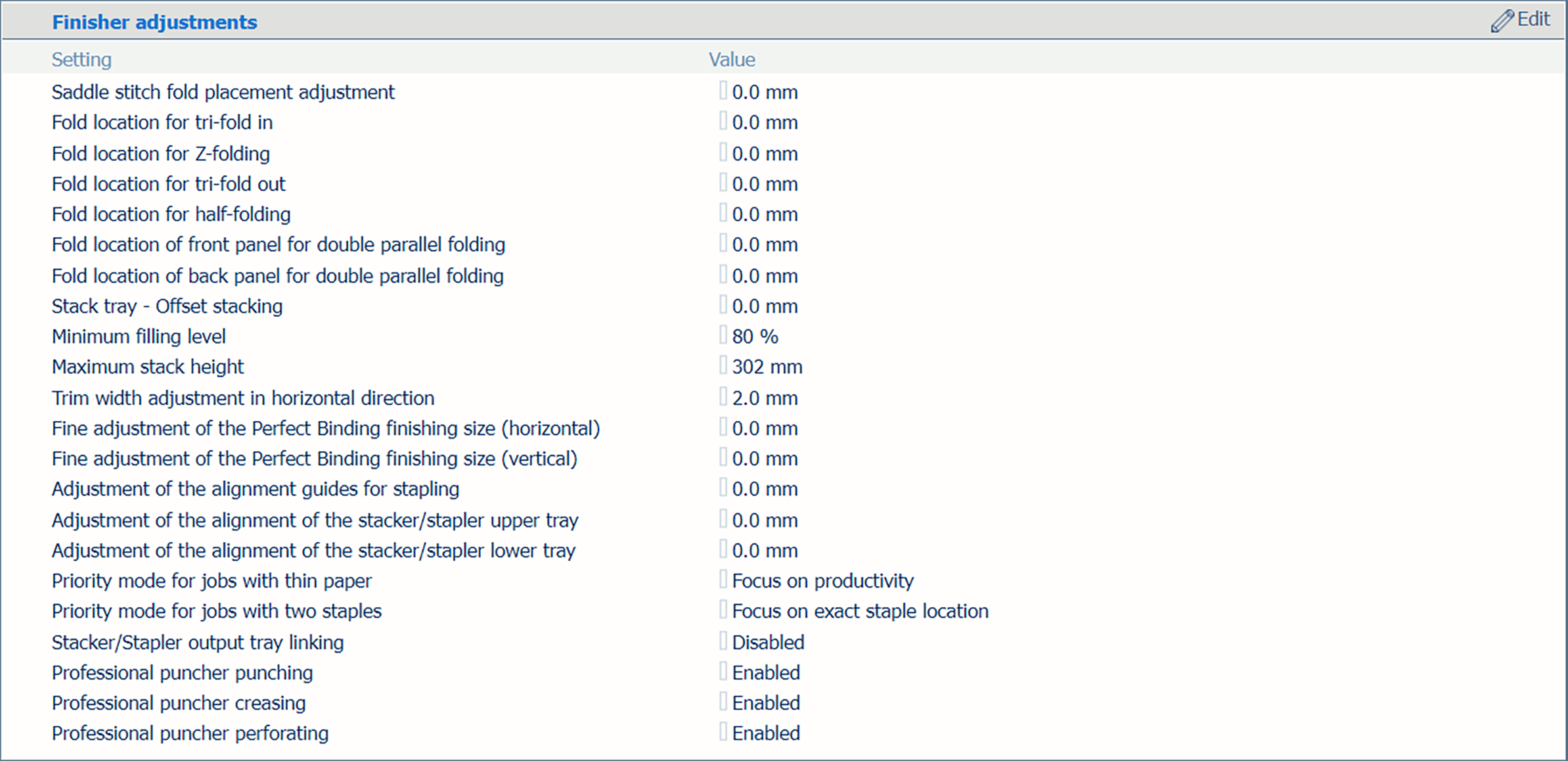 [Finisher adjustments] section
[Finisher adjustments] sectionUse the [Stacker/Stapler output tray linking] setting to link the output trays of the stacker/stapler.
Enable [Enabled, output tray linking only] when you want to combine the lower and upper tray of the stacker/stapler for the delivery of the jobs.
Enable [Enabled, output tray linking with high-volume mode] when you want to combine tray linking with an enlarged upper and lower tray sheet capacity (up to 5,000 sheets).
Some media are not supported for the high-volume mode, for example, envelopes. In this case, output tray linking can still be used but without high-volume mode.
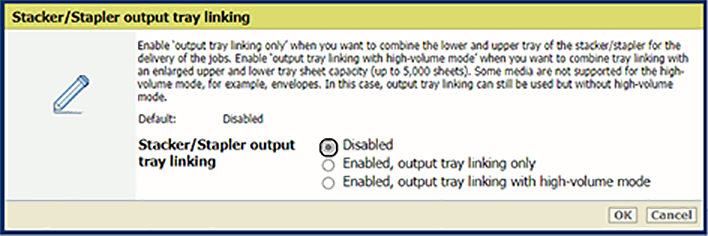 [Stacker/Stapler output tray linking] setting
[Stacker/Stapler output tray linking] settingGo to the [Stacker] section.
 [Stacker] section
[Stacker] sectionUse the [Top tray - Preferred feed edge] and [Stack tray - Preferred feed edge] setting to indicate if the long or short side of the sheet refers to the feed direction of the sheets by default.
[Long-edge feed (LEF)]: long-edge feed direction.
[Short-edge feed (SEF)]: short-edge feed direction.
 Default feed direction
Default feed directionUse the [Top tray - Face orientation] and [Stack tray - Face orientation] settings to indicate if the front side of the prints points up or down by default.
[Face up]: front side of first printed sheet is visible.
[Face down]: back side of last printed sheet is visible.
 Default face orientation
Default face orientationUse the [Top tray - Header orientation] and [Stack tray - Header orientation] settings to indicate if the header of the prints points to the front side of the printer or to the back side of the printer by default.
[Header-up]: header of printed document pages points to the back side of printer.
[Header-down]: header of printed document pages points to the front side of printer
 Default header orientation
Default header orientationUse the [Top tray - Preferred sheet order] and [Stack tray - Preferred sheet order] settings to define the default order of the prints.
[First sheet first]: the first source file page is printed first.
[Last sheet first]: the last source file page is printed first.
 Default sheet order
Default sheet orderGo to .
 [System adjustments] tab
[System adjustments] tabGo to the [Finisher adjustments] section.
 [Finisher adjustments] section
[Finisher adjustments] sectionUse the [Stack tray - Offset stacking] setting to define the offset value. When the offset value is '0' offset stacking is disabled. The default offset value is 15 mm (0.59 inch).
 [Stack tray - Offset stacking] setting
[Stack tray - Offset stacking] settingUse the [Minimum filling level] setting to define the filling level in the stack tray.
The minimum filling rate is a percentage of the maximum stack height. The default value is 80%. The high capacity stacker ejects the stack as soon as the stack height exceeds the minimum filling rate. The minimum filling rate is active in case the high capacity stacker ejects a stack when the stack tray is full.
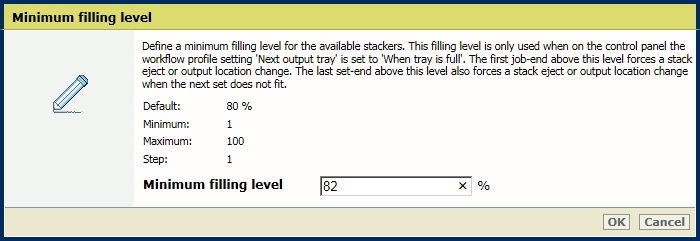 [Minimum filling level] setting
[Minimum filling level] settingUse the [Maximum stack height] setting to define the maximum stack height in the stack tray.
The default stack height is 302 mm (11.9 inch). The minimum stack height is 10 mm (0.39 inch). The maximum stack height is 345 mm (13.58 inch). When the stack height is larger than the default stack height, there is a risk that sheets fall off the stack when the eject tray moves out.
 [Maximum stack height] setting
[Maximum stack height] settingGo to: .
Go to the [Perfect Binder] section.
 [Perfect Binder] section
[Perfect Binder] sectionUse the [Stacker tray - Preferred feed edge] setting to define the feed direction of the sheets on the output tray.
[Long-edge feed (LEF)]: long-edge feed direction.
[Short-edge feed (SEF)]: short-edge feed direction.
 [Stacker tray - Preferred feed edge] setting
[Stacker tray - Preferred feed edge] settingUse the [Stacker tray - Preferred face direction] setting to define the default face direction.
[Face up]: front side of first sheet points up.
[Face down]: back side of last printed sheet points down.
 [Stacker tray - Preferred face direction] setting
[Stacker tray - Preferred face direction] settingUse the [Stacker tray - Preferred header direction] setting to define the default header direction.
[Header-up]: header of printed document pages points to the back side of printer.
[Header-down]: header of printed document pages points to the front side of printer
 [Stacker tray - Preferred header direction] setting
[Stacker tray - Preferred header direction] settingUse the [Stacker tray - Preferred sheet order] setting to define the default order of the printed sheets within a job set.
[First sheet first]: deliver the first sheet of each set first.
[Last sheet first]: deliver the last sheet of each set first.
 [Stacker tray - Preferred sheet order] setting
[Stacker tray - Preferred sheet order] settingGo to: .
Go to the [Basic] section.
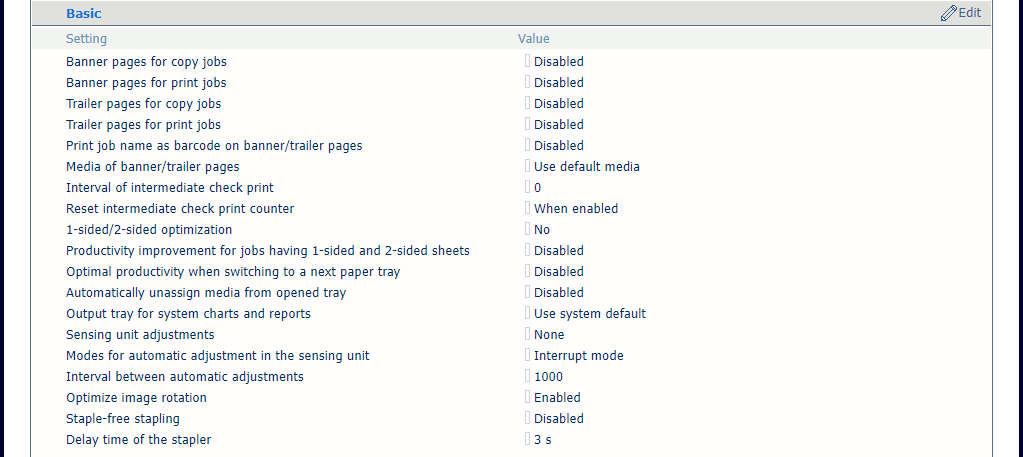 [Basic] section
[Basic] sectionUse the [Staple-free stapling] setting to enable staple-free stapling.
When you enable staple-free stapling, the job specification is evaluated to determine if the staple can be replaced by the staple-free alternative (crimping and binding the sheets). Staple-free stapling is limited to jobs that have three to five sheets. The exact number of sheets depends on the media size, weight and feed direction.
 [Staple-free stapling]
[Staple-free stapling] Use the [Delay time of the stapler] settings to define the time after which stapling takes place from the moment you manually insert the sheets into the stapling slit.
 [Delay time of the stapler]
[Delay time of the stapler]